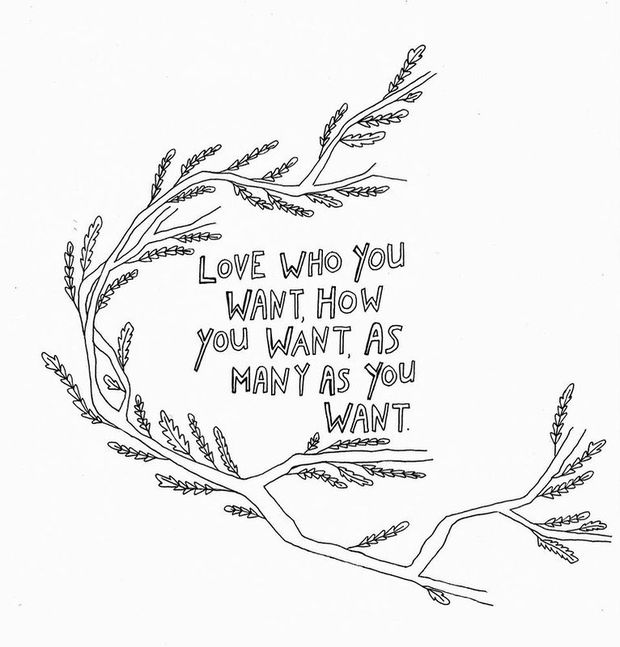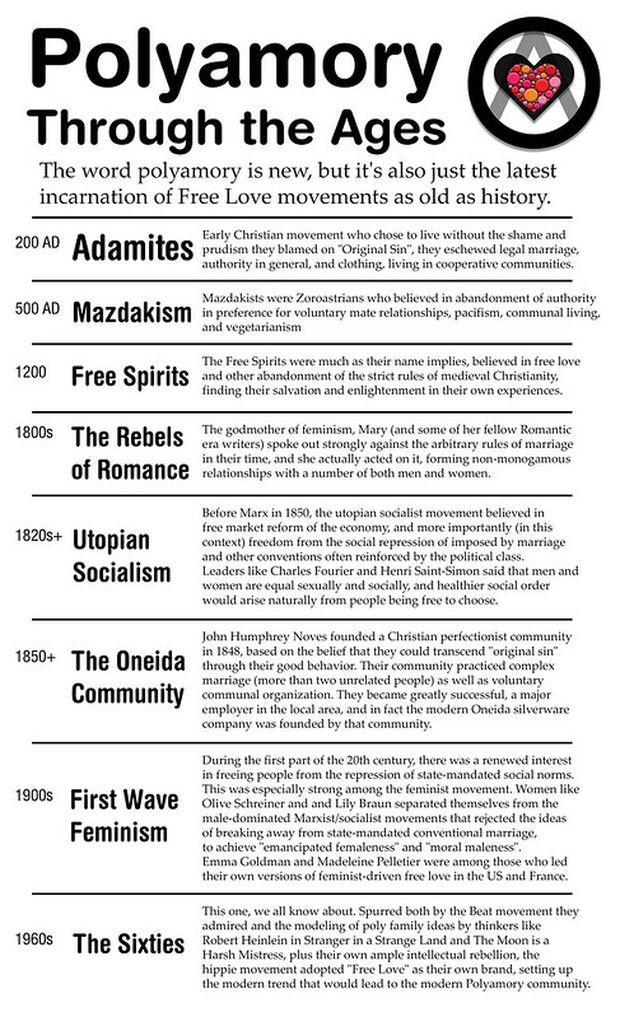The concept of open relationships, also known as non-monogamy, has a long and varied history. Non-monogamy has been practised in a variety of forms by many different cultures throughout history.

One of the earliest recorded examples of non-monogamy comes from ancient Sumeria, where men were allowed to have multiple wives and concubines. In ancient Greece, it was common for men to have multiple sexual partners, both male and female, outside of their primary relationship. In some Native American cultures, polygamy was practised, in which a man could have multiple wives.
In modern Western culture, the concept of non-monogamy has evolved over time. In the mid-20th century, the counterculture movement of the 1960s and 70s embraced the idea of free love and non-monogamy. This was reflected in the popularisation of the concept of "swinging," in which couples would engage in sexual activity with other couples.
Today, the concept of open relationships encompasses a wide range of practices, including polygamy, swinging, and polyamory.
Open relationships may involve a range of different agreements and dynamics, and the specific terms of an open relationship will depend on the individuals involved.
The concept of open relationships, or relationships in which the participants are romantically or sexually involved with other people outside of the primary relationship, has a long history.
While the specific origins of open relationships are difficult to trace, non-monogamy and non-exclusive relationships have been a part of human society for centuries.
One possible precursor to the modern concept of open relationships is the practice of polygamy or the custom of having multiple spouses. Polygamy has been practised in many cultures throughout history and continues to be practised in some societies today.
In polygamous societies, relationships were often hierarchical, with one spouse considered the primary partner and the others considered secondary.
Another possible precursor to open relationships is the concept of "serial monogamy," in which people have multiple monogamous relationships over the course of their lifetime. This practice has been common in many societies and can be seen as a form of non-monogamy in which the relationships are not concurrent.
The modern concept of open relationships can also be traced back to the 70s when the sexual revolution and the women's liberation movement took place. This came about as a way to challenge the traditional gender roles and relationship models and people started to explore alternative relationship models.
Today, the concept of open relationships remains a source of controversy and confusion for many people. The details and dynamics of these types of relationships can vary greatly, but the idea of having non-monogamous or non-exclusive relationships is an important aspect of the lives and relationships of a significant number of individuals.
In contrast, the concept of polyamorous relationships, or relationships in which the participants are involved in multiple romantic or sexual relationships simultaneously with the knowledge and consent of all parties involved, has a somewhat more recent history.
The practice of non-monogamy and non-exclusive relationships has a long history within human society. However, the term "polyamory" and the modern understanding of polyamorous relationships as a specific type of relationship are more recent phenomena.

In fact, it began to reach the mainstream in the early 2000s, with the publication of books such as "The Ethical Slut" and "Opening Up”. This literature explored and depicted the potential benefits and challenges of polyamorous relationships.
What truly defines the concept of polyamorous relationships is the fact that consent and communication are above anything else.

Poly relationships can take many forms, and the specific dynamic of each poly relationship will depend on the individual needs and boundaries of the people involved.
In an open relationship, the primary partners may or may not be aware of and consent to the other outside relationships. They may involve a range of different agreements and dynamics, and the specific terms of an open relationship will depend on the individuals involved.

What are the main differences between polyamory and open relationships?
In a polyamorous relationship, there are typically multiple romantic or sexual relationships happening simultaneously. However, in an open relationship, there is usually a primary relationship and outside relationships.
In a polyamorous relationship, communication, consent and boundaries are essential. All parties involved must be aware of and consent to the other relationships. There is full transparency in poly relationships. In contrast, in an open relationship, the level of communication and boundaries may vary, although consent is always the basis of any kind of relationship.
In a poly relationship, there is often a level of equality among the various relationships, although it gets more specific in some types of polyamorous relationships. Whereas, in an open relationship, there is usually a hierarchy established, where a primary relationship that takes precedence over the outside relationships.
In a poly relationship, exclusivity is not typically a requirement for a successful partnership, whereas, in an open relationship, exclusivity within the primary relationship is generally expected, but outside relationships may or may not be exclusive.
Motivations and specific aims for choosing an open versus a polyamory relationship vary. Some individuals choose polyamorous relationships to form deep, meaningful connections with multiple partners, with the intention of building a network of loving and supportive relationships.
Others, choose polyamory relationships as a desire for personal growth and self-exploration, a belief in the inherent value of non-monogamy, or a preference for the flexibility and fluidity that polyamorous relationships can offer.
The relationship structure of both types of relationships is different: Polyamorous relationships involve the formation of romantic and/or sexual connections with multiple partners, with the understanding that all of these connections are equally valid and important.
Polyamorous relationships can take many different forms and may involve a variety of different structures, including group relationships, hierarchical relationships, and solo polyamorous relationships, among others.

However, in an open relationship, the primary partnership is typically considered the central focus, and outside sexual or romantic connections are often kept separate from the primary relationship.
The specific parameters of an open relationship may vary, but it is typically understood that there is an expectation of monogamy within the primary partnership, while the individuals in the relationship are free to engage in additional sexual or romantic relationships outside of the primary one.
Should you be in an open relationship or a polyamorous one?
Whether someone should be in an open relationship or a polyamorous relationship is a highly personal decision that will depend on their individual needs, values, and beliefs.
Deciding whether to be in an open relationship or a polyamorous one is a personal decision that depends on your individual values, needs, and comfort level.
It's important to carefully consider what works best for you and your partner(s) before making any decisions. Some individuals worry about the stigma or ethical judgement about which of those relational models is best.
Let us clarify that, it’s not possible to determine which type of relationship is "better", as each person's needs and preferences are unique. Both open relationships and polyamorous relationships can be successful and fulfilling for some people, but may not be the right fit for others.
It's essential to find what works best for you and your partner(s) and to be open to the possibility that your needs and desires may change over time.
It is crucial to have open and honest communication with your partner(s) about your needs and boundaries and to be willing to compromise and make adjustments as needed. You should also be prepared for the challenges that can arise in any type of non-traditional relationships, such as jealousy or insecurity.
If you're unsure about what path to take, it may be helpful to speak with a therapist or a trusted friend or family member for guidance. Ultimately, the most important thing is, to be honest with yourself and your partner(s) about what you want and need from your relationship.
Lastly, considering whether an open or polyamorous relationship might be right for you or which one defines you better, make sure you:
- Understand what your own intentions, desires and drives are when deciding the kind of partnerships that adjust better to your personality.
Ask yourself,
- Do you value non-monogamy and believe it can be a valid and fulfilling way to have a relationship?
- Do you enjoy sexual variety or want to explore outside relationships while maintaining a primary partnership?
- Do you believe that monogamy is essential to a healthy relationship, or do you see value in non-monogamy as a valid relationship model?
Scratching deeper into your own motivations, values and beliefs, as well as, being able to confidently answer those questions can help you decide on which type of relationship you would be more comfortable in.
- Another very important aspect is to determine and consider whether you have the required skills to handle jealousy and insecurity. This is because both open and polyamorous relationships can involve navigating such feelings due to sharing multiple partners.
If you are not able to recognise and address those negative feelings of rivalry, envy, jealousy, apprehension and similar in a healthy way, then, an open or polyamorous relationship may not be a good fit for you.

Final Thoughts
Both polyamorous and open relationships can be healthy, fulfilling and successful as long as all parties involved are aware of and consent to the terms of the relationship and everyone's needs are being met.
It is very important to remember that relationships are fluid and can evolve and change over time. Hence, having consistent ongoing honest communication is so crucial to make adjustments as needed.
